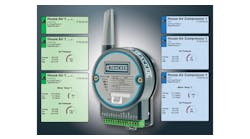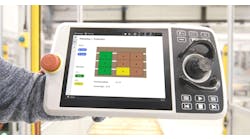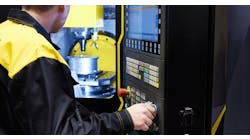Platform for Smart Factory Automation
Overcoming the Machinist Shortage
All Axis Machining is metal fabricating business in Dallas with five-axis CNC machining capability and 11-axis combined mill/turn capability. But, the operation had problems implementing an effective automation concept for its machinery. The rapidly growing role of robotics in manufacturing operations presents considerable opportunities for enhancing productivity, but it’s a challenge to coordinate the latest automation technologies with existing capital machinery.
Then, All Axis Machining discovered that Universal Robotics — the developer that introduced the first cobot (collaborative robot) in 2008— offers an open integration architecture through its Universal Robots+ platform, and that made the difference. Very soon, the shop had automated six different operations with collaborative robots. The deployment was so successful that All Axis started a new business, offering UR cobot integration services to other machine shops.
Cobots are robots design to operate autonomously or interactively with humans in a common work zone.
“Last year, we could not even spell robot,” said Dave Perkowski, general manager at All Axis Machining, where multiple collaborative robots now automate CNC machine-tending, sanding, deburring, part inspection, laser marking, and wire EDM processes. “We had no actual robotic integration and automation. Being able to immediately start interfacing cobots with our machines has been unbelievable.”
All Axis Machining started to look for automation because, like many manufacturers, it faced a lack of available manual labor, and that led to undesirable machine downtime. “It drove me pretty crazy when all the guys were out to lunch, and none of the machines were working,” owner Gary Kuzmin said. “After 5pm, we’d have a skeleton shift with only half the machines running. It was costing me orders that I couldn’t get to my customers on time.”
A major obstacle in automating operations was the fact that All Axis’ machines were legacy equipment with no direct interface for traditional industrial robots. “Also, an industrial robot requires a fence around it; we weren’t ready to give up floor space — or more important, to be locked into using the robot for one task only,” Kuzmin explained.
No hidden integration costs — Having exhausted their options with conventional robotics, the Texas machine shop discovered collaborative robots could be a possible solution. “We got a demo of Universal Robots and quickly realized that these cobots offered easy integration through the controllers of our old machines,” recounts the machine shop owner. The communication between the UR cobots and All Axis’ machines is made possible through the UR+ platform, that through a free Software Development Kit (SDK) allows users to develop their own plug-ins, so-called URCaps, that integrates the control of the entire application right through the cobot’s own teach pendant.
“Universal Robots has done a fantastic job of making this solution available to shops like ours,” said Perkowski. “The operating system is open, I’m not locked into a proprietary environment. We’re basically given this cookbook with an easy way to expand communication,” he said, adding that All Axis uses protocols such as TCP/IP, Ethernet, Modbus and Profinet to connect cobots and machines.
“From a technology perspective it’s heaven to have all these capabilities and take our current systems and integrate without any other assistance,” the general manager said.
For emphasis, he added that there are no hidden costs. “An advantage is we don’t have to pay special license agreements, it all comes with the purchase of the UR cobot. We simply signed up on the UR website to become a developer, and we downloaded the elements we need.”
The UR+ platform addresses the trial-and-error associated with equipping the robot arm with peripherals, such as end-effectors, force sensors, vision cameras, and other accessories. The platform features a showroom with more than 100 products certified to work seamlessly with the Universal Robots. “We were able to browse the showroom and quickly bring UR+ grippers and tool changers off the shelf and onto the cobots,” Kuzmin said.
60% profit increase — As with any machine shop owner, Kuzmin worries about the bottom line. When All Axis Machining got its first UR10 cobot, the company had a job slated to take four to five months of run-time on one machine with the current staffing.
“We couldn’t hire any additional staff at that point, so we took the robot, put it on the CNC machine and actually delivered that part almost two and a half months early because of all the additional machine time that we realized,” he recounted. “We saw a 60% profit increase on that job alone. ROI was about a four-month return. Our spindle up-time has gone from about eight hours a day to about 20 effective hours.”
Soon, All Axis also discovered that the UR10 cobot’s 50-microns accuracy was crucial to its performance, specifically with its precise insertion in laser marking and CNC machines, as well as in sanding and deburring. “Our sanding used to be all manual and lines from tool marks could not always be avoided,” Kuzmin said. “With the UR10 that part came out perfectly straight; in fact, the customer called us up and said they were impressed, and wanting to know what we did differently.”
Empowering employees — When the machine shop first researched the cobots, the managers were curious to find out how different the programming and operation would be, specifically for operators with no prior experience. All Axis Machining had its employees go through the UR Academy, consisting of free, interactive online modules that teach basic programming and set-up.
“We had an elderly operator doing the sanding, which requires a lot of muscle,” Kuzmin recalled. One day, while watching the operator on a monitor he saw the operator pick up the cobot’s teach pendant to start programming it to sand the part.
“I’ve never been more proud to see one of our employees learn a brand-new technology. This is really empowering and is going to improve his whole lifestyle, and earning capability as well,” the shop owner said.
One cobot, many tasks — All Axis Machining is not a high-volume shop. It typically runs more than 20 different parts per day and needed quick change-overs, both between tools at the end of the robot arm and in terms of moving the robot between machines to be tended.
“We need to achieve change-overs in about 5-10 minutes at the most. The UR+ program allowed us to find products for the robot that all had quick disconnects. The platform even gave us the tools to develop some ourselves,” said Perkowski, adding that All Axis has also developed mobile platforms that wheel the cobots between jobs.
All Axis Robotics start-up — Half a year into the cobot automation project, All Axis Machining managers realized their expertise could easily be extended to other machine shops facing the same automation challenge.
“We suddenly saw a whole new business emerging,” said Kuzmin, who established All Axis Robotics, a new company dedicated to integrating turnkey UR cobot solutions for metal fabrication. ”When a company calls us now, we can come in, look and evaluate what their needs are, and on any of their equipment—no matter how old it might be—we can probably implement a robot into their operations,” said the shop owner, adding that people might wonder why he would be helping out the competition. “What we compete for is labor. There’s plenty of business out there for all of us to have,” he said. “Integrating cobots into legacy machines is what will really drive manufacturing in the United States.”








